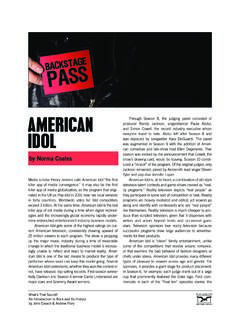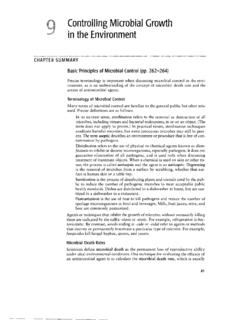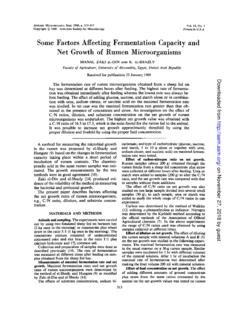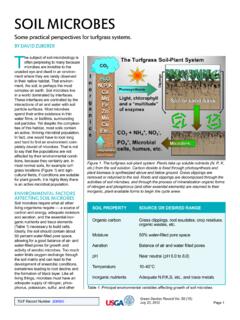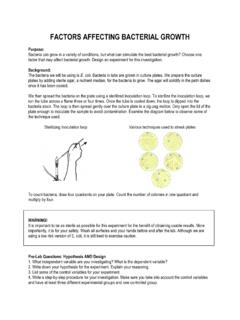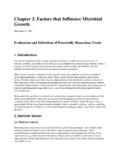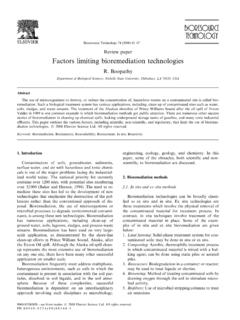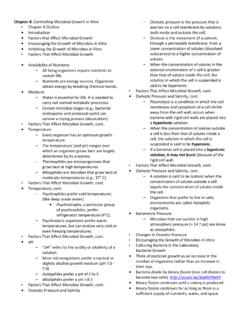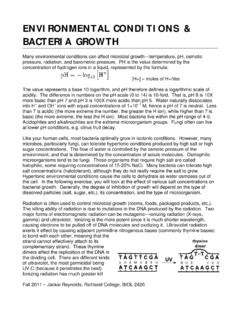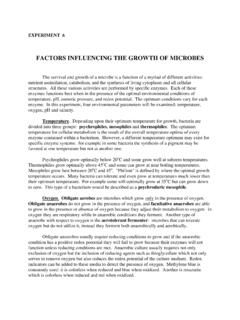Transcription of CHAPTER 5 Environmental Influences and Control of ...
1 CHAPTER 5 environmental influences and control of microbial growth Summary In this CHAPTER we learn about Environmental limits on microbial growth and how organisms adapt to changes in their environments. Sometimes the adaptations are temporary stress-reducing solutions, but in other cases adaptive mutations occur. The latter, of course, result in genetic change and evolution. By understanding all aspects of microbial growth and adaptation, we can better Control organisms that are pathogenic to plants, animals, or humans. Environmental Limits on growth It is at this point that the term extremophile is introduced. An extremophile is any organism that lives outside of our normal human range of reference.
2 Introduce different Environmental parameters, including temperature, pH, osmolarity, oxygen, and pressure. Describe the ranges of possible conditions under each of these categories. Make sure to point out what is considered normal. Discussion Points The Environmental parameters are listed in Table along with the classifications for each group of organisms. Ask students to identify the temperature category in which pathogens belong. Use Fig. to introduce techniques that allow for global analysis of gene expression in changing environments. Adaptation to Temperature Microbes do not have the ability, as we do, to regulate temperature. Their temperature matches that of their environment.
3 All organisms have a range of temperatures within which they can survive. Every organism also has an optimum temperature at which it grows best. The temperature limits on growth are dictated by the proteins in the cell and the structure of the cell membrane. Microorganisms are classified by their optimum growth temperature. Microorganisms can be classified as psychrophiles, mesophiles, thermophiles, and hyperthermophiles, and each classification has its own set of special characteristics. A recurring topic throughout the text is the polymerase chain reaction (PCR). Discuss the importance of the discovery of the thermozyme from Thermus aquaticus that allowed automation of this process. IM5-1 Discussion Points Fig.
4 Illustrates the Arrhenius equation and its relationship to growth . The temperature classification groups are illustrated in Fig. Discuss the shape and meaning of the curves. Psychrophiles and thermophiles can be found in some rather unique places. Figs. and show some of these locations and the organisms found there. Special Topic describes the role of bacteria in rainmaking and ice formation. Adaptation to Pressure The terms barotolerant and barophilic are introduced. The barophiles are an interesting group of organisms since they contain both psychrophiles and thermophiles, many of which have been isolated from the ocean floor. Discussion Points Fig. is an interesting depiction of the topography of Earth s surface.
5 Point out temperature variances found at the ocean floor. Fig. clearly illustrates the barosensitive, barotolerant, and barophilic classifications. Water Activity and Salt In this section many terms must be introduced before the concepts can be explained. In particular, it is important to explain water activity. Only after understanding water activity should discussions lead to osmolarity and ways organisms have evolved to deal with osmotic stress. Emphasis is placed on the important distinction between hypotonic and hypertonic solutions. The concept of compatible solutes came up in a previous CHAPTER and appears again here in the discussion about coping mechanisms under osmotic stress and for halophiles.
6 Discussion Points Aquaporins are specialized membrane channels used to transport water and to protect organisms from osmotic stress. A transverse view of an aquaporin channel is shown in Fig. Halophilic salt flats can range in color from pinkish red to red, and even to a dark purple. An example of a salt flat in Nevada is shown in Fig. , along with an SEM of a halophilic bacterium. IM5-2 Adaptation to pH Changes Whereas intracellular temperature matches that of the microbe s environment, the intracellular pH is maintained near neutrality, regardless of the external pH. This occurs because proteins operate only near neutral conditions. There are three classes of organisms, based on the pH range within which they function best.
7 Before these are defined, the concept of pH needs to be fully understood. The acidophiles thrive at low pH and have tetraether membranes, which means that proton permeability is decreased. Neutralophiles thrive at neutral or near neutral pH. The alkaliphiles occupy the high end of the pH spectrum. They are commonly found in environments that not only have a high pH but high salt concentrations as well. Their membranes have diether linkages. Also of interest is the fact that these organisms have evolved to utilize a sodium rather than a proton motive force. Discussion Points Fig. serves to illustrate pH. It not only shows how pH and pOH relate to one another and to hydrogen ion concentration, it also shows where the acidophiles, neutralophiles, and alkaliphiles fall along the pH scale.
8 To help solidify the concept of pH, Fig. lists common household items at each pH. Also note that to the left of the pH is the concentration of hydrogen ions at each pH as compared to distilled water. Figs. and illustrate how cytoplasmic pH is maintained over a wide range of external pH. Figs. and can be referenced to illustrate specialized environments. Fig. is especially interesting because it describes why pink flamingos are pink (due to their ingestion of pink cyanobacteria, whose pigment enters the flamingos bloodstream, turning their feathers the same color). Alkaliphiles have evolved to utilize a sodium motive force versus a proton motive force. This concept is illustrated in Fig.
9 Many bacteria have developed strategies to maintain internal pH homeostasis. The mechanisms used by E. coli are described and diagrammed in Fig. Oxygen and Other Electron Acceptors Some organisms require oxygen. At the other end of the spectrum are organisms that die in the presence of oxygen. It should be noted that they do not die from the oxygen per se, but rather that in the presence of oxygen these organisms produce reactive oxygen molecules, which kills the cells. IM5-3 Although respiration and fermentation are only introduced here and will be detailed in other chapters, they are important concepts to discuss initially. Once these terms have been introduced it is possible to describe facultative aerobes, facultative anaerobes, and microaerophiles.
10 The methods for culturing anaerobes in the laboratory are different from methods of culturing aerobes. Typical methods used are the anaerobic jar and an anaerobic chamber with glove ports. Discussion Points To set the stage for this section, use Fig. to illustrate oxygen levels throughout a test tube and the categorization of types of organism found in each range. Use Table to introduce organisms that fall into each of these categories. Use Fig. to illustrate and briefly describe aerobic respiration with the use of oxygen as the terminal electron acceptor. Since anaerobic respiration also uses cytochromes and the electron transport system, examine Fig. and simply point out that the cell would use a terminal electron acceptor other than oxygen.

